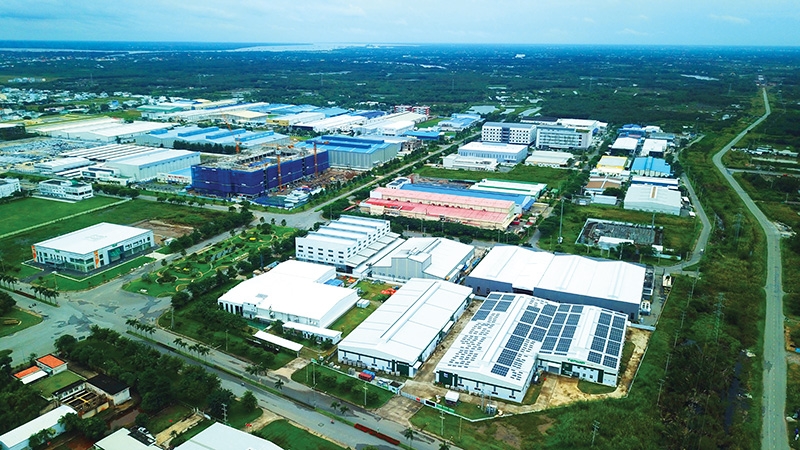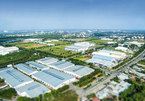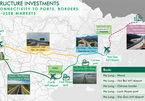 |
|
The demand for land, factories, and warehouses surged, causing rents in industrial zones to rise even further, photo Le Toan
|
The current rapid and high rise in rents at industrial parks and factories is creating great pressure on manufacturers and may deter investors who are looking for profitable properties to realise their projects.
A representative of one company said the high rent increases are significantly impacting the manufacturing system.
“We don’t even know at which level the next rents will be and cannot expand our operation or warehouse space as we’re unable to calculate our budget,” said the representative.
Under current regulations, tenants should be able to choose to pay rent once for the entire lifetime of the project or submit annually. However, many landlords are forcing their tenants to pay annually, which means that rent can also increase each time.
Pham Thi Minh Hieu, director of Hoang Ha Technology Co., Ltd. in Ho Chi Minh City’s Hoa Phu Industrial Park, said that her company has a land leasing contract with the landlord until 2057 but the landlord insists on annual payments that can be increased, causing much trouble and financial loss to her company.
Meanwhile, Nguyen Manh Trung, another tenant in Ho Chi Minh City reported that the rent was stable in the first five years, and was then bumped up with the condition that the increase would be no more than 15 per cent of the agreed fee.
“But since 2015, many tenants could not calculate their costs as Decree No.142/2005/ND-CP from 2005 stipulates that the land rent is only fixed for five years. Afterwards, it can be recalculated based on the market price of neighbouring land plots,” said Trung.
“Land lease fees fluctuate continuously and some localities only allow tenants to pay annually. But when doing so, tenants cannot receive a red book, so they cannot mortgage their assets,” he added.
According to real estate experts, increasing land rents are making it difficult for project owners to invest in industrial parks as they are placed in a negative status with their business when considering the costs and efficiency of each project.
John Campbell, manager of Industrial Services at Savills Vietnam, told VIR that the rapid increase in land rates affects occupancy rates, especially in new industrial zones that are in need of investment.
“There are several investors who expressed their concerns about the current hike in prices, while there are already high occupancy rates in many localities, which means that this higher demand will push prices even higher,” said Campbell.
Vacant land in many main areas in the north and south of Vietnam is becoming increasingly scarce.
Consequently, some companies are now looking at alternative tier 2 provinces such as Tay Ninh, Binh Phuoc, Binh Thuan, Ba Ria-Vung Tau, and Vinh Long in the south, and Vinh Phuc, Thai Nguyen, Bac Giang, Ha Nam, Thai Binh, and Quang Ninh in the north.
Escalating rents
Demand for land, factories, and warehouses surged, causing rent in industrial zones close to major cities to escalate. Figures from CBRE show that the demand for industrial real estate has recorded continuous growth in the past few quarters.
Ho Chi Minh City and Hanoi are leading in rent increases, while the average rent of other provinces in the north and in the south has been increasing by up to 30 per cent compared to the same period of last year.
In Ho Chi Minh City, some industrial zones charged $150 per square metre last year, which has now increased to $300 per sq.m for a term of 30-45 years. In Dong Nai province, rent per sq.m increased from $100 to $155 per term. Long An province recorded an increase from $110 to $200 per sq.m per term.
During the last months of 2020, rents continued to increase by nearly 25 per cent compared to the previous quarter, with industrial zones such as Hiep Phuoc and Tan Tao seeing price hikes of up to 37 per cent. In Binh Duong province, rents are up 22 per cent.
Meanwhile, ready-built factories are also continuously setting new prices. The current rent sits at $4-5 per sq.m per month, compared to $3.50 three years ago. Rents for ready-built warehouses also increased by up to 10 per cent in new projects compared to the same period of 2019.
As existing industrial zones are gradually being filled, the scarcity becomes even more serious, while new projects are still waiting for official approval from the government to start operations. Real estate experts argued that the current price fluctuations for industrial land are unprecedented, with those fees not even including VAT and management and service fees.
Investments catch up
As one of the most attractive destinations for investment in Southeast Asia, Vietnam has received more than $3 billion into the industrial property segment during the last two years, mainly flowing into private equity, institutional funds, and pension funds.
The country’s market has been occupied by some well-known players such as VNL of VinaCapital, VPF of Dragon Capital, Indochina Capital, and Saigon Asset Management.
Warburg Pincus, one of the largest international private equity firms, has invested in Vingroup’s accommodation and retail arm and industrial property via a joint venture named BW Industrial Development, together with domestic Becamex IDC, to develop a ready-built factory and warehouse system in Vietnam.
BW Industrial Development so far has accumulated over 1.2 million sq.m of gross floor area at the end of 2020. As of the third quarter of last year, the company had 21 projects in key industrial hubs nationwide, including ready-built factories, logistics warehouses, as well as sale-and-leaseback units.
LOGOS, a growing logistics developer headquartered in Sydney, officially announced its entry into Vietnam to establish a portfolio that was initially forecast at $350 million. The firm boasts some of the world’s largest fund managers as its shareholders, including ARA Asset Management, a leading Asia-Pacific real assets fund manager.
According to Glenn Hughes, CEO of LOGOS Vietnam, his company is developing its first Vietnam-based asset – a 13-hectare development site within VSIP Bac Ninh Industrial Park.
“For LOGOS, expansion into the country happened in direct response to the increasing demand from clients in the region,” Hughes said.
“While a few years ago, it was mainly Chinese investors targeting Vietnam, now the country is in everybody’s sights. Facing this huge demand pressure, the nation is likely to see land and construction prices for industrial parks go up, in addition to the country-specific challenges such as the slow land clearing processes,” he added.
Many other developers and investors are rushing into the Vietnamese market. Among them, SEA Logistic Partners has set up a joint venture with GLP to develop modern logistics real estate in Vietnam. The first three developments are set up in the northern provinces of Bac Ninh and Bac Giang and the southern province of Long An.
Gaw Capital Partners, a real estate private equity firm with a global portfolio of over $36 billion, has teamed up with NP Capital Partners to set up Gaw NP Industrial, which is injecting around $200 million into high-quality logistics warehouses, ready-built factories, and built-to-suit facilities. Its first project – Gaw NP Yen Binh located in Thai Nguyen province – is now going to open for the first tenant sometime this month. VIR
Bich Ngoc

Industrial property continues dominating Vietnam’s 2020 real estate sector
Industrial property continues dominating the market thanks to the fast growing manufacturing industry.

Vietnamese industrial market update – Rise of coastal industrial zones
The demand for industrial property at coastal regions is high, but the supply of industrial land ready to hand over in industrial zones in both regions was scarce.